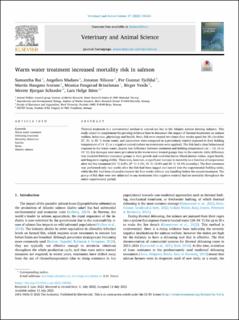| dc.contributor.author | Bui, Samantha | |
| dc.contributor.author | Madaro, Angelico | |
| dc.contributor.author | Nilsson, Jonatan | |
| dc.contributor.author | Fjelldal, Per Gunnar | |
| dc.contributor.author | Iversen, Martin Haugmo | |
| dc.contributor.author | Brinchmann, Monica Fengsrud | |
| dc.contributor.author | Venås, Birger | |
| dc.contributor.author | Schrøder, Merete Bjørgan | |
| dc.contributor.author | Stien, Lars Helge | |
| dc.date.accessioned | 2022-09-19T07:18:10Z | |
| dc.date.available | 2022-09-19T07:18:10Z | |
| dc.date.created | 2022-08-22T15:44:36Z | |
| dc.date.issued | 2022 | |
| dc.identifier.citation | Veterinary and Animal Science. 2022, 17, 1-12. | en_US |
| dc.identifier.issn | 2451-943X | |
| dc.identifier.uri | https://hdl.handle.net/11250/3018669 | |
| dc.description.abstract | Thermal treatment is a controversial method to control sea lice in the Atlantic salmon farming industry. This study aimed to complement the growing evidence base to document the impact of thermal treatments on salmon welfare, behaviour, physiology and health. Here, fish were treated two times (four weeks apart) for 30 s in either 27, 30, or 33 °C warm water, and parameters were compared to a procedural control (exposed to their holding temperature of 14 °C) or a negative control (where no treatments were applied). The fish had a clear behavioural response to the warm water, despite low difference between treatment and holding temperature (Δt = 13, 16 or 19 °C). Eye damages were more prevalent in the warm water treated groups than in the controls. Little difference was recorded between treatment groups in their growth and condition factor, blood plasma values, organ health, and long-term coping ability. There was, however, a significant increase in mortality as a function of temperature after the first treatment (14 °C: 6.5%, 27 °C: 5.3%, 30 °C: 12.4% and 33 °C: 18.9% mortality). The first treatment was performed only two weeks after the fish had been tagged and moved into the experimental holding tanks, while the fish had been allowed to recover for four weeks without any handling before the second treatment. The group of fish that were not subjected to any treatments (the negative control) had no mortality throughout the entire experimental period. | en_US |
| dc.language.iso | eng | en_US |
| dc.publisher | Elsevier | en_US |
| dc.rights | Navngivelse 4.0 Internasjonal | * |
| dc.rights.uri | http://creativecommons.org/licenses/by/4.0/deed.no | * |
| dc.subject | Atlantic salmon | en_US |
| dc.subject | Stress | en_US |
| dc.subject | Injuries | en_US |
| dc.subject | Behaviour | en_US |
| dc.subject | Mortality | en_US |
| dc.subject | Delousing treatment | en_US |
| dc.subject | Warm water treatment | en_US |
| dc.title | Warm water treatment increased mortality risk in salmon | en_US |
| dc.title.alternative | Warm water treatment increased mortality risk in salmon | en_US |
| dc.type | Peer reviewed | en_US |
| dc.type | Journal article | en_US |
| dc.description.version | publishedVersion | en_US |
| dc.rights.holder | © 2022 The Author(s). Published by Elsevier Ltd | en_US |
| dc.source.pagenumber | 12 | en_US |
| dc.source.volume | 17 | en_US |
| dc.source.journal | Veterinary and Animal Science | en_US |
| dc.identifier.doi | 10.1016/j.vas.2022.100265 | |
| dc.identifier.cristin | 2045066 | |
| dc.relation.project | Fiskeri- og havbruksnæringens forskningsfinansiering: 901649 | en_US |
| dc.source.articlenumber | 100265 | en_US |
| cristin.ispublished | true | |
| cristin.fulltext | original | |
| cristin.qualitycode | 1 | |

